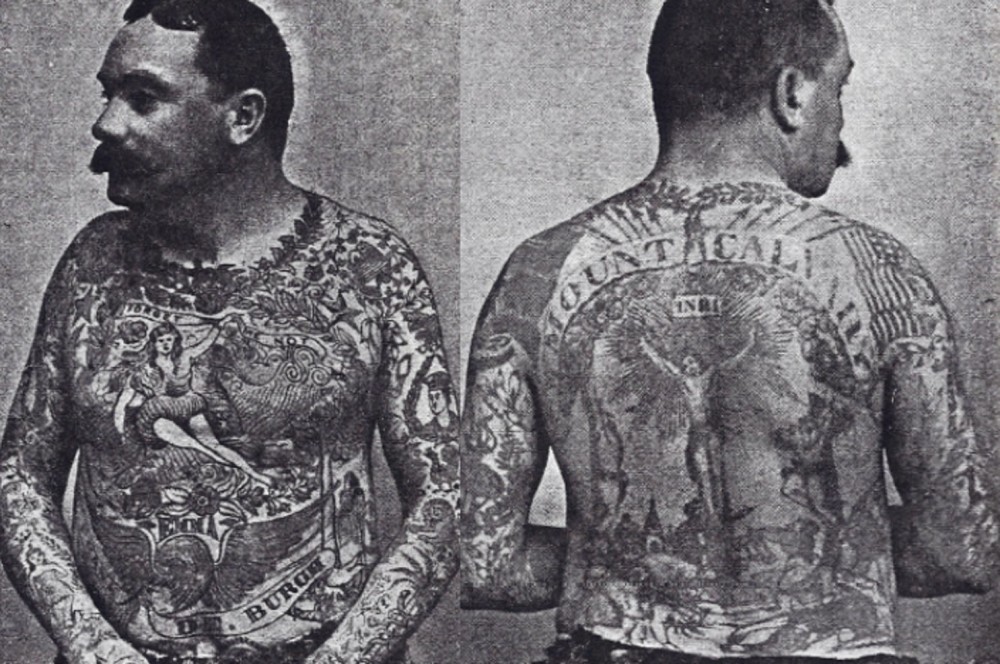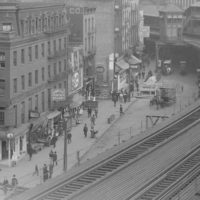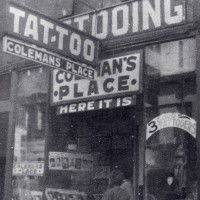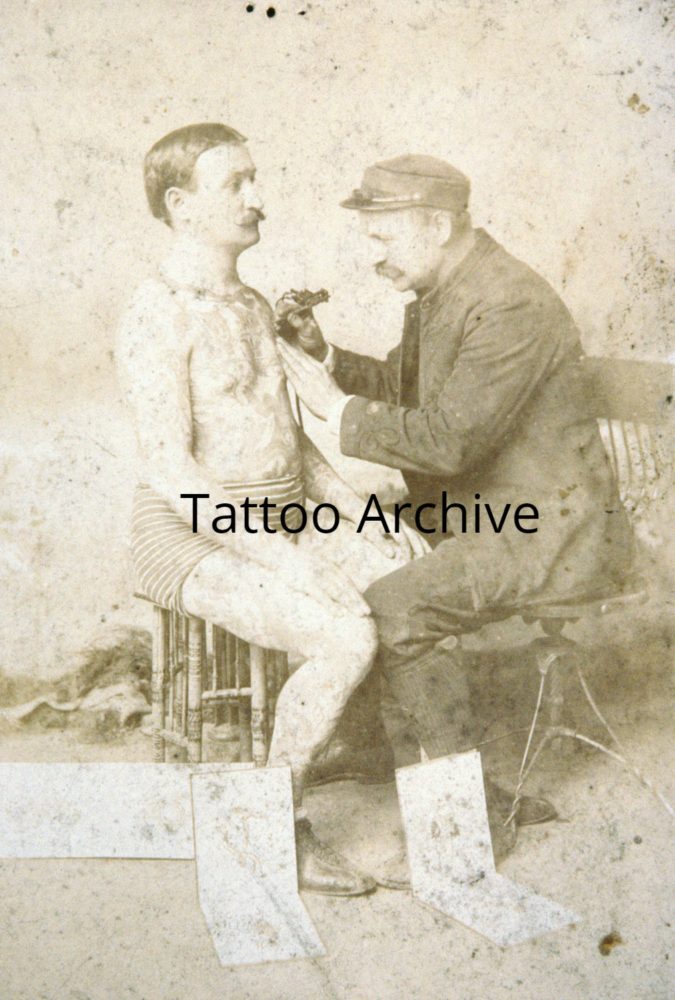
Elmer Getchell tattooing Otto Schmidt c. 1902. Collection of Tattoo Archive
‘Electric’ Elmer Getchell
Researched & Written by Carmen Nyssen
Born: February 7, 1863 Holton, Aroostook, ME
Died: May 22, 1940 District of Columbia
Burial: Riverside-Magnolia Cemetery, Sec: Wysteria, Lot 135
Learn more about Elmer Getchell’s involvement with the invention of electric tattoo machines on the Early Tinkerers of Electric Tattooing page.
Getchell’s Tattoo Career
According to family, Captain Elmer Ellsworth Getchell (aka Electric Elmer Getchell) was a scholarly man and a “jack of all trades;” he was a horseshoer, tattooer, and water color artist. He enjoyed painting sunrises and sunsets and always brushed in 3 seagulls representative of the Holy Trinity.
As his moniker suggests, Getchell was also a steamboat captain and spent much of his life trekking up and down the East Coast. In later years, he settled in Norfolk, Virginia, but kept multiple tattoo shops in seaport cities, such as Baltimore and Washington D.C., so he could wield his needle in between port calls during his steamboat travels.
Boston Tattoo Tradition
Elmer Getchell’s start in tattooing—probably sometime at the turn of the 1880s decade—was no doubt influenced by the seafaring tradition. Though born in Maine, Getchell grew up in Boston, Massachusetts, home to a U.S. Naval shipyard and a considerable fishing and whaling trade. With the hundreds of seaman passing through the busy maritime hub, a tattooer stood to make a decent living. According to a 1930 Lancaster New Era newspaper article, Getchell had indeed learned the art of tattooing “when but a boy” … “from a sailor along the wharves in Boston.”
Getchell’s Tattooed Attractions
Boston’s dime museum scene, which rivaled that of the legendary New York Bowery, was an equally lucrative avenue for tattoo artists. The growing popularity of dime museums during the 1880s era brought with it a demand for an assortment of oddity acts, including the crowd-drawing tattooed attraction. From at least 1888, until 1892, Getchell tattooed at Austin & Stone’s Museum at 4 Tremont Row in Scollay Square, and like his contemporary, eminent New York Bowery tattoo artist, Samuel O’Reilly, covered several well-known tattooed performers for exhibition.
1888 Oct 23 Boston Daily Globe: “Young, Unmarried Man wanted with a capital of $400 or $500 to invest in a sure thing; a golden chance for the right man. Call or address E.E. Getchell, tattooing artist in museum, 4 Tremont Row.”
By Austin & Stone’s Museum – https://archive.org/stream/historyofbostont02tomp, Public Domain, https://commons.wikimedia.org/w/index.php?curid=18528652
—
Capt. Fred Hadley: Tattooed Attraction
One early tattooed attraction Getchell covered for exhibition was Ambrose Fred Hadley, aka Capt. Fred Hadley, who was a car driver for the street railway in Boston before he decided to get covered in tattoos and exhibit with circuses and dime shows. Though he only performed from 1884 to 1887, he had several pitch photos made and a pitch pamphlet documenting his story of becoming a tattooed man (see end note).
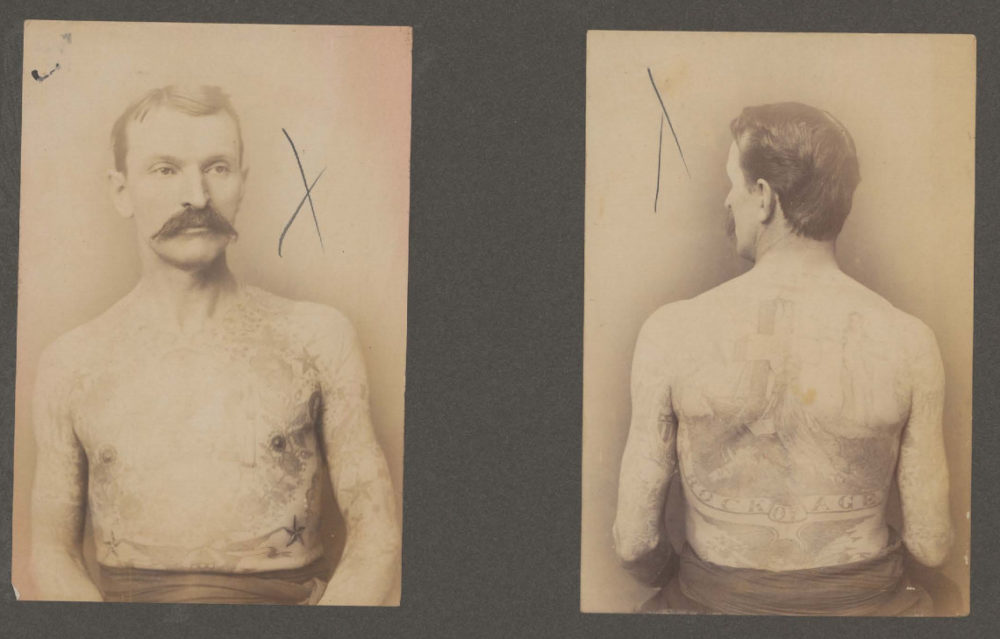
Tattooed Man, Capt. Fred Hadley with the John Robinson Circus. “From the Collection of the Public Library of Cincinnati and Hamilton County.” Used with permission.
—
According to an April 21, 1884 Chicago Tribune article, Hadley was so pleased with Getchell’s tattoo work he gifted him a commemoration medal:
“Presented to Elmer E. Getchell by Frank [sic] Hadley for tattooing him from head to foot. Commenced Nov 26, 1883; completed Jan 28, 1884.”
Hadley’s pitch pamphlet, The Life of Capt. Fred Hadley: The Tattooed American, additionally names Martin Hildebrandt, Stephen Lee, and “J. Thomas” (probably Edwin Thomas) as other fine American tattoo artists of the era.
James Burke: Tattooed Attraction
The best recognized among Getchell’s tattooed men was James Burke (1846-1909), aka Frank Deburgh, who as it happens, was the husband of one of O’Reilly’s most notable tattooed creations, Mrs. Emma Deburgh.
—
Frank DeBurgh Tattoos
Deburgh’s tattoos were described in full detail in an April 21, 1884 Chicago Tribune newspaper report about Elmer Getchell:
Boston Globe: “Turn around, Jim, and let them see the Crucifixion. Two men, seated on chairs, sat facing each other in a room on North Street. One of them was dressed in a navy uniform. His name was Elmer E. Getchell. The other was a Boston citizen named James Burke, and he was dressed in a light and airy costume of a pair of trunks. There was nothing more upon him in the way of clothing, but he had more decoration on his body than any man in the State. He was tattooed from his neck down to his toe-nails, with all kinds of figures of men, beasts, birds, flowers, ships, and shapes of every kind. His thighs were covered with idols, etc., placed there when he was in Burmah, eight years ago. All the rest of the work was new and had been put on within a few weeks by Mr. Getchell. The figures were blue and red, and the various figures were drawn in skillful and artistic style. As the tattooed man turned around, his back showed the commencement of a picture of the Crucifixion, copied after the large steel engraving by Hilton.
“I have a good deal to do on this man yet. That picture will cover all of the back and extend around to the sides. You see only the three figures on the crosses now, but I will work in all the other figures that are in the picture, and show the City of Jerusalem in the distance.”
Getchell’s Crucifixion Tattoo
Deburgh’s stunning back tattoo was a replication of William Hilton’s 1827 “Crucifixion” painting, now archived in the Walker Art Gallery in Liverpool England. A large steel engraving of this same image had also been reproduced by William Finden in 1852.
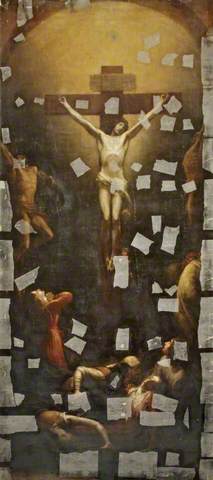
(c) Walker Art Gallery; Supplied by The Public Catalogue Foundation
—
Tattooers Elmer Getchell & Sam O’Reilly
That Getchell had covered popular tattooed performer Frank Deburgh, And O’Reilly had tattooed his famed wife Emma, Is an interesting juxtaposition. In much later years, the two tattoo artists were partners until they became engaged in a notoriously heated court battle over who invented the electric tattoo machine. In 1891, O’Reilly secured the first tattoo machine patent for a device based on Thomas Edison’s rotary stencil pen. Some years later, Elmer Getchell apparently invented a just as revolutionary machine made from a doorbell mechanism, most likely based on his own machine trials over the years. According to the court case, he had manufactured and sold a sizable quantity of them, which prompted O’Reilly to file an infringement claim with the U.S. Federal Court. Getchell then left O’Reilly’s 5 Chatham Square tattoo shop and opened his own down the street at 11 Chatham Square, a shop later inhabited by O’Reilly (c. 1904), then Charlie Wagner (c. 1909)).
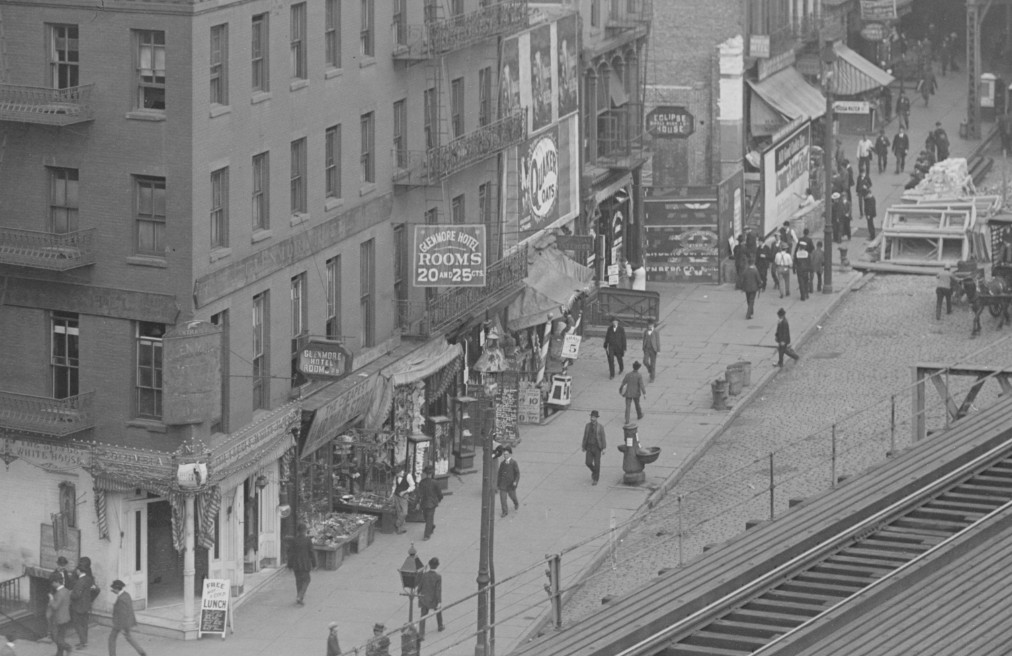
Sam O’Reilly’s 5 Chatham Square Tattoo Shop. C. 1900. Sign just above awning, under the Quaker Oats sign, states “Prof. O’Reilly Tattooer.” Courtesy of Library of Congress.
—
Elmer Getchell Bowery Tattooer
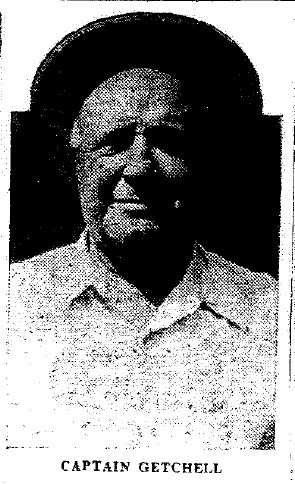 Just after parting ways with O’Reilly, Elmer Getchell engaged in business with several other partners in New York City. A notation on a 1902 passenger manifest for tattoo artist Sidney B. Wright’s wife, states she was traveling from England to join her “Husband S.B. Wright NY Bowery,” an “electric tattooist” working with (what appears to be written as) “Prof. Getchell.” That same year, Getchell had formed, and dissolved, a partnership with John W. Rose, who as noted in city directories, either lived with Getchell or at least in the same building.
Just after parting ways with O’Reilly, Elmer Getchell engaged in business with several other partners in New York City. A notation on a 1902 passenger manifest for tattoo artist Sidney B. Wright’s wife, states she was traveling from England to join her “Husband S.B. Wright NY Bowery,” an “electric tattooist” working with (what appears to be written as) “Prof. Getchell.” That same year, Getchell had formed, and dissolved, a partnership with John W. Rose, who as noted in city directories, either lived with Getchell or at least in the same building.
1902 New York City Dir pg 1144
John W. Rose tattooing 11 Chatham sq h 92 Washington Byklyn
1902 Polk’s (Trow’s) New York Co-partnership and Corporation Directory Vol 50
Getchell & Rose (dissolved) 11 Chatham Sq
1902 Brooklyn City Dir pg 461
Elizabeth Getchell, wid, Edw’d, h 46 Flint
Elmer E. Getchell tattooer, h 92 Wash’n
Elsworth Getchell artist, h 46 Flint
Note: It’s not clear if the Elsworth Getchell listed in the household of Getchell’s mother, at 46 Flint, and listed as an artist, is Elmer Getchell himself or his son Elmer Ellsworth Getchell Jr.. Elmer Jr. was Getchell’s son from his first marriage to Alice O’Brien. In 1891, Getchell divorced her because of an alleged drinking problem. She initially took custody of their two children and moved from Boston to New London, Connecticut. However, for a short while, around 1902, Elmer Jr. and daughter Eva lived with Getchell, when he was in New York City. He’s possibly the Elsworth Getchell listed with Elizabeth, his grandmother.
Diane Deblois of the Ephemera Society published an article describing Fred Hadley’s pitch pamphlet, The Life of Capt. Fred Hadley: The Tattooed American, in the December 2001 issue of Book Source Monthly.
Additional Buzzworthy Tattoo History article related to Elmer Getchell:
And read about Getchell’s British tattoo partner: Jim Wilson Traveling Tattooer
Also See:


